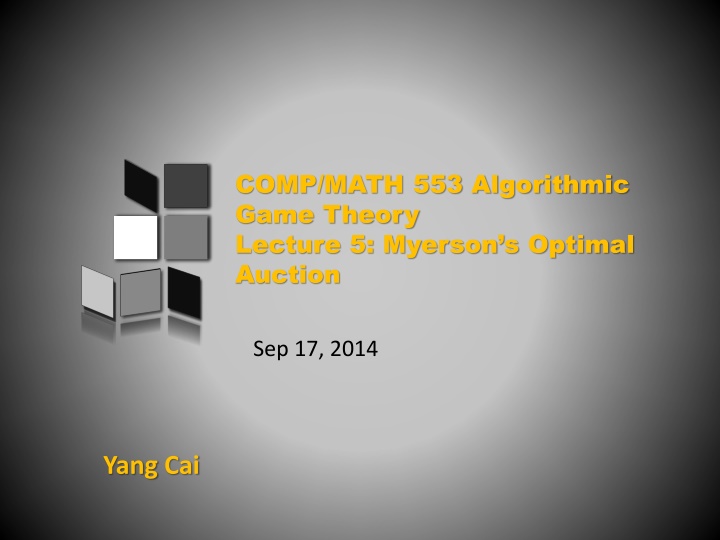
Algorithmic Game Theory Lecture: Myerson's Optimal Auction Overview
Explore Myerson's Optimal Auction, Bayesian Analysis Model, Revenue-Optimal Auctions, and more in the context of algorithmic game theory. Learn about dominant strategy equilibriums, revenue maximization, and the Revelation Principle. Dive into the concept of virtual welfare and expected revenue in single-dimensional environments.
Download Presentation

Please find below an Image/Link to download the presentation.
The content on the website is provided AS IS for your information and personal use only. It may not be sold, licensed, or shared on other websites without obtaining consent from the author. If you encounter any issues during the download, it is possible that the publisher has removed the file from their server.
You are allowed to download the files provided on this website for personal or commercial use, subject to the condition that they are used lawfully. All files are the property of their respective owners.
The content on the website is provided AS IS for your information and personal use only. It may not be sold, licensed, or shared on other websites without obtaining consent from the author.
E N D
Presentation Transcript
COMP/MATH 553 Algorithmic Game Theory Lecture 5: Myerson s Optimal Auction Sep 17, 2014 Yang Cai
An overview of todays class Expected Revenue = Expected Virtual Welfare 2 Uniform [0,1] Bidders Example Optimal Auction
Revelation Principle Recap . . . . . . b1 b2 bn New Mechanism M . . . . . . S1( ) S2( ) Sn( ) S1(b1 ) S2(b2 ) Sn(bn) Original Mechanism M x(s1(b1), s2(b2),...,sn(bn))
Revenue Maximization
Bayesian Analysis Model A single-dimensional environment, e.g. single-item The private valuation vi of participant i is assumed to be drawn from a distribution Fi with density function fi with support contained in [0,vmax]. We assume that the distributions F1, . . . , Fnare independent (not necessarily identical). In practice, these distributions are typically derived from data, such as bids in past auctions. The distributions F1 , . . . , Fnare known in advance to the mechanism designer. The realizations v1, . . . , vnof bidders valuations are private, as usual.
Revenue-Optimal Auctions [Myerson 81 ] Single-dimensional settings Simple Revenue-Optimal auction
What do we mean by optimal? Step 0: What types of mechanism do we need to consider? In other words, optimal amongst what mechanisms? Consider the set of mechanisms that have a dominant strategy equilibrium. Want to find the one whose revenue at the dominant strategy equilibrium is the highest. A large set of mechanisms. How can we handle it? Revelation Principle comes to rescue! We only need to consider the direct- revelation DSIC mechanisms!
Expected Revenue = Expected Virtual Welfare
Revenue = Virtual Welfare [Myerson 81 ] For any single-dimensional environment. Let F= F1 F2 ... Fn be the joint value distribution, and (x,p) be a DSIC mechanism. The expected revenue of this mechanism Ev~F[ i pi(v)]=Ev~F[ i xi(v) i (vi)], where i (vi) := vi- (1-Fi(vi))/fi(vi) is called bidder i s virtual value (fi is the density function for Fi).
Myersons OPTIMAL AUCTION
Two Bidders + One Item Two bidders values are drawn i.i.d. from U[0,1]. Vickrey with reserve at If the highest bidder is lower than , no one wins. If the highest bidder is at least , he wins the item and pay max{1/2, the other bidder s bid}. Revenue 5/12. This is optimal. WHY???
Two Bidders + One Item Virtual value for v: (v)= v- (1-F(v))/f(v) = v- (1-v)/1= 2v-1 Optimize expected revenue = Optimize expected virtual welfare!!! Should optimize virtual welfare on every bid profile. For any bid profile (v1,v2), what allocation rule optimizes virtual welfare? ( (v1), (v2))=(2v1-1, 2v2-1). If max{v1,v2} 1/2, give the item to the highest bidder Otherwise, (v1), (v2) < 0. Should not give it to either of the two. This allocation rule is monotone.
Revenue-optimal Single-item Auction Find the monotone allocation rule that optimizes expected virtual welfare. Forget about monotonicity for a while. What allocation rule optimizes expected virtual welfare? Should optimize virtual welfare on every bid profile v. - max i xi(v) i (vi). , s.t i xi(v) 1 Call this Virtual Welfare-Maximizing Rule.
Revenue-optimal Single-item Auction Is the Virtual Welfare-Maximizing Rule monotone? Depends on the distribution. Definition 1 (Regular Distributions): A single-dimensional distribution F is regular if the corresponding virtual value function v- (1-F(v))/f(v) is non- decreasing. Definition 2 (Monotone Hazard Rate (MHR)): A single-dimensional distribution F has Monotone Hazard Rate, if (1-F(v))/f(v) is non-increasing.
Revenue-optimal Single-item Auction What distributions are in these classes? - MHR: uniform, exponential and Gaussian distributions and many more. - Regular: MHR and Power-law... - Irregular: Multi-modal or distributions with very heavy tails. When all the Fi s are regular, the Virtual Welfare-Maximizing Rule is monotone!
Two Extensions Myerson did (we wont teach) What if the distributions are irregular? - Point-wise optimizing virtual welfare is not monotone. - Need to find the allocation rule that maximizes expected virtual welfare among all monotone ones. Looks hard... - This can be done by ironing the virtual value functions to make them monotone, and at the same time preserving the virtual welfare. We restrict ourselves to DSIC mechanisms - Myerson s auction is optimal even amongst a much larger set of Bayesian incentive compatible (BIC) (essentially the largest set) mechanisms. - For example, this means first-price auction (at equilibrium) can t generate more revenue than Myerson s auction. Won t cover them in class. - Section 3.3.5 in Mechanism Design and Approximation , book draft by Jason Hartline. - Optimal auction design , the original paper by Roger Myerson.
